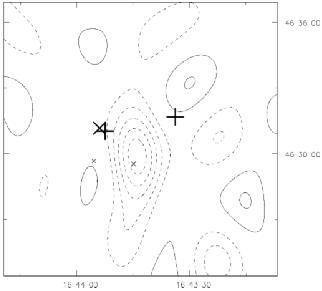


As mentioned in the introduction, the SZ effect is independent of
redshift. This makes
it possible to look for microwave diminutions towards distant clusters,
even in those cases
which there is nothing visible in X-ray or optical emission. As a step
in this direction, the
Ryle Telescope has been used to search for an SZ effect in front of
distant quasar pairs.
In one such case, the pair PC1643+4631A & B, an effect was found
(Jones et al. (1997)),
with a clear `dip' in the CMB between the two quasars (see
Fig. 5). This is most likely
due to an intervening cluster of galaxies, but no associated X-ray
emission is found at this position, and optical/infra-red searches show
no evidence for a cluster at a redshift z
 1
(Saunders et
al. (1997)).
The quasars have redshifts of 3.79 and 3.83 and a separation
of ~ 3 arcminutes. A possible interpretation is that they are two images
of the same
source. This would be a very wide separation lens by normal standards,
but the total
cluster mass inferred from the CMB observations is
1
(Saunders et
al. (1997)).
The quasars have redshifts of 3.79 and 3.83 and a separation
of ~ 3 arcminutes. A possible interpretation is that they are two images
of the same
source. This would be a very wide separation lens by normal standards,
but the total
cluster mass inferred from the CMB observations is
 1015
M
1015
M , which is large enough to
do the lensing required. The quasar spectra are very similar, and the
redshift difference
could possibly be explained by a time delay between the paths (which is
expected to be
about 1000 years) coupled with intrinsic variation in the source
(Saunders et
al. (1997)).
Further optical observations are underway to try to settle this
point. We mention this
detection in the context of a review on using the CMB to constrain
H0, in order to
emphasize that objects considerably farther away than are currently
being used may
eventually be useful in determining H0 and
q0.
, which is large enough to
do the lensing required. The quasar spectra are very similar, and the
redshift difference
could possibly be explained by a time delay between the paths (which is
expected to be
about 1000 years) coupled with intrinsic variation in the source
(Saunders et
al. (1997)).
Further optical observations are underway to try to settle this
point. We mention this
detection in the context of a review on using the CMB to constrain
H0, in order to
emphasize that objects considerably farther away than are currently
being used may
eventually be useful in determining H0 and
q0.

|
Figure 5. CMB decrement towards the
z = 3.79, 3.83 quasar pair PC1643+4631A, B. Contour
levels are -325 to +130µJy in steps of 65 µJy; dashed
contours are negative. The `+' crosses
show the positions of the quasars; the `x' crosses show the positions
of radio sources that have
been removed, the size of the cross being proportional to the removed
flux. The redshift of the
cluster responsible is not known, but from X-ray and optical/infra-red
limits must be |